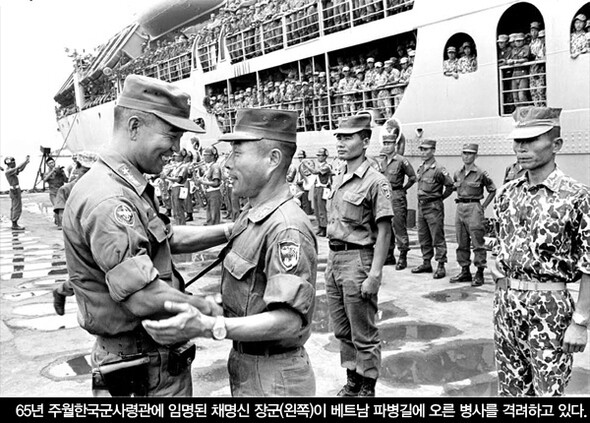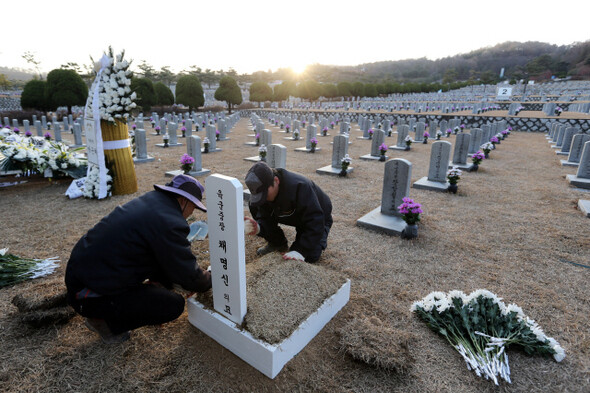hankyoreh
Links to other country sites 다른 나라 사이트 링크
Vietnam war commander to be buried among fallen comrades

By Kim Kyu-won, staff reporter
South Korea’s first commander of troops in the Vietnam War is set to be buried alongside enlisted soldiers who died in the conflict.
Retired Lt. Gen. Chae Myung-shin, who passed away on Nov. 25, was reported by many to have been tormented by the deaths of soldiers under his command in Vietnam. He would be the first general in South Korean history to be interred in a cemetery for enlisted troops.
The Ministry of National Defense announced the plan in a press release on Nov. 27, saying Chae was to be buried in the enlisted soldier’s section of Seoul National Cemetery in accordance with wishes he expressed during his lifetime.
“This decision was made out of the utmost respect for the deceased’s noble wish to be with his fallen comrades from the Vietnam War even in death,” the ministry said.
Chae is to be buried in the second enlisted soldiers’ graveyard at the cemetery, where he previously staged memorial events as chairman of the association of Vietnam War veterans. Like the other soldiers, he was buried in a plot measuring 3.3 square meters, with the same type of headstone. As a general, he was entitled to a 26.4 square meter plot.
The ministry quoted Chae as telling his family before his death that he did not want to be buried in the graveyard for generals, specifically requesting an interment in the enlisted men’s graveyard in Seoul’s Dongjak neighborhood where his Vietnam War comrades are buried.
After he passed away, his family members made a request to the ministry and Blue House for a burial in the enlisted soldier’s graveyard at Seoul National Cemetery, which houses the remains of soldiers who died in the Vietnam War. The government initially balked, citing a lack of precedent, but ultimately decided to honor Chae’s will and the wishes of his family.
Defense Minister Kim Kwan-jin paid a visit to Seoul Asan Hospital in Songpa district, where Chae’s remains had been lying in state, to announce the government’s decision in person. Calling Chae a “spiritual pillar of the army,” he told the family the government had agreed to honor the request for his burial alongside the other officers and men.
The funeral took place on the morning of Nov. 28 as an official army funeral at Seoul National Cemetery.
Chae had reportedly been opposed to South Korea’s participation in the Vietnam War at first, concerned about guerrilla battles in dense jungle and the outstanding leadership of North Vietnam’s Ho Chi Minh.
He was ultimately appointed the first commander of the ROK forces in Vietnam in 1965, a position he held until 1969. He and the military achieved their share of merits, but at great cost: of the 320,000 South Korean troops fighting over nine years, some 5,000 died, another 11,000 were injured, and 160,000 suffered aftereffects of exposure to chemical defoliants. People who knew Chae reported that he was deeply distressed over the casualties.
Born in 1926 as the son of an anti-Japanese activist in Goksan, Hwanghae Province (in today’s North Korea), Chae came to South Korea in 1947 and joined the Chosun Guard Academy (now known as the Korea Military Academy) as part of the institution’s fifth incoming class of cadets.
After leading the “Skeleton” guerrilla unit during the Korean War and taking part in the 1961 coup that overthrew the Second Republic, he returned to the army once the military administration ended.
In 1972, during his period as 2nd Army Commander, the lieutenant general was relieved of his position for opposing the Park Chung-hee administration’s Yushin coup. At the time, sources reported him telling part that politics “is about keeping a promise to the people. It’s a leader’s lifeblood, and if you go on this way, you’re sacrificing your own life.”



Please direct questions or comments to [english@hani.co.kr]

Editorial・opinion
![[Guest essay] Maybe Korea’s rapid population decline is an opportunity, not a crisis [Guest essay] Maybe Korea’s rapid population decline is an opportunity, not a crisis](https://flexible.img.hani.co.kr/flexible/normal/500/300/imgdb/original/2024/0430/9417144634983596.jpg) [Guest essay] Maybe Korea’s rapid population decline is an opportunity, not a crisis
[Guest essay] Maybe Korea’s rapid population decline is an opportunity, not a crisis![[Column] Can Yoon steer diplomacy with Russia, China back on track? [Column] Can Yoon steer diplomacy with Russia, China back on track?](https://flexible.img.hani.co.kr/flexible/normal/500/300/imgdb/original/2024/0430/1617144616798244.jpg) [Column] Can Yoon steer diplomacy with Russia, China back on track?
[Column] Can Yoon steer diplomacy with Russia, China back on track?- [Column] Season 2 of special prosecutor probe may be coming to Korea soon
- [Column] Park Geun-hye déjà vu in Yoon Suk-yeol
- [Editorial] New weight of N. Korea’s nuclear threats makes dialogue all the more urgent
- [Guest essay] The real reason Korea’s new right wants to dub Rhee a founding father
- [Column] ‘Choson’: Is it time we start referring to N. Korea in its own terms?
- [Editorial] Japan’s rewriting of history with Korea has gone too far
- [Column] The president’s questionable capacity for dialogue
- [Column] Are chaebol firms just pizza pies for families to divvy up as they please?
Most viewed articles
- 1Under conservative chief, Korea’s TRC brands teenage wartime massacre victims as traitors
- 2[Guest essay] Maybe Korea’s rapid population decline is an opportunity, not a crisis
- 3Months and months of overdue wages are pushing migrant workers in Korea into debt
- 4[Column] Can Yoon steer diplomacy with Russia, China back on track?
- 5‘We must say no’: Seoul defense chief on Korean, USFK involvement in hypothetical Taiwan crisis
- 6After election rout, Yoon’s left with 3 choices for dealing with the opposition
- 7First meeting between Yoon, Lee in 2 years ends without compromise or agreement
- 8[Column] Behind factional animus of Korean politics, victim mentality festers
- 9Dermatology, plastic surgery drove record medical tourism to Korea in 2023
- 10Why Kim Jong-un is scrapping the term ‘Day of the Sun’ and toning down fanfare for predecessors